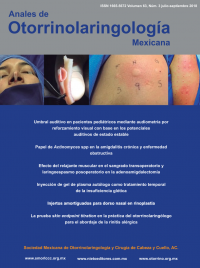Auditory threshold in pediatric patients obtained by visual reinforcement audiometry compared to the results obtained by steady-state evoked potential.
An Orl Mex. 2018 julio-septiembre;63(3):87-96.
Ana Teresa De la O-Gómez,1 Ileana Gutiérrez-Farfán,1 Emilio Arch-Tirado,2 Úrsula Gutiérrez-Canencia,1 Ana Luisa Lino-González2
1 Servicio de Audiología. Posgrado de Alta Especialidad de Audiología Pediátrica.
2 Subdirección de Investigación Biomédica, División de Neurociencias, Área de Neurobiología.
Instituto Nacional de Rehabilitación Luis Guillermo Ibarra Ibarra, Ciudad de México, México.
Resumen
ANTECEDENTES: La audiometría por reforzamiento visual y los potenciales auditivos de estado estable permiten identificar umbrales auditivos.
OBJETIVO: Comparar en pacientes pediátricos el umbral auditivo mediante la audiometría por reforzamiento visual vs potenciales auditivos de estado estable.
MATERIAL Y MÉTODO: Estudio transversal, comparativo, observacional y descriptivo, efectuado de febrero a septiembre de 2017 en pacientes de dos a cinco años de edad; se les realizó audiometría por reforzamiento visual y potenciales auditivos de estado estable, en las frecuencias 500, 1000, 2000 y 4000 Hz. Se evaluaron con estadística descriptiva, gráficas de error para evaluar la tendencia de los datos, t de Student para determinar diferencia significativa para muestras relacionadas con p < 0.05, intervalos de confianza para la media e intersección probabilística de AꓵB.
RESULTADOS: Se incluyeron 38 pacientes. En la mayor parte de las evaluaciones, los valores fueron inversos en lo que respecta a los promedios y desviaciones estándar obtenidas en los potenciales auditivos y la audiometría por reforzamiento visual. La probabilidad de mayor coincidencia entre ambas pruebas con TDH39 y campo libre se encontró en el oído derecho en la frecuencia de 500 Hz.
CONCLUSIONES: Es preciso realizar la audiometría por reforzamiento visual de forma aleatoria en ambos oídos y frecuencias evaluadas con el fin de obtener resultados puntuales en la determinación del umbral auditivo y procurar asegurar el adecuado condicionamiento previo.
PALABRAS CLAVE: Audiometría por reforzamiento visual; potenciales auditivos; umbral auditivo; hipoacusia.
Abstract
BACKGROUND: The visual reinforcement audiometry and steady-state evoked potential are tests that allow to identify auditory thresholds.
OBJECTIVE: To compare the date obtained throw the visual reinforcement audiometry and the steady-state evoked potential in the determination of the auditory threshold in pediatric patients.
MATERIAL AND METHOD: A cross-sectional, comparative, observational and descriptive study was done from February to September 2017 in children participating in a visual reinforcement audiometry and a steady-state evoked potential in 500, 1000, 2000 and 4000 Hz. Descriptive statistic tests and error graphs were also performed to evaluate the trend of the data, t-Student test to determine significant difference for samples related to p < 0.05, confidence intervals for the mean and probabilistic intersection of AꓵB.
RESULTS: In most evaluations, the values are inverse with respect to the averages and standard deviations. The highest correlations were found in the frequency of 2000 Hz with TDH39. The probability of greater coincidence between both tests with TDH39 and free field was found in the right ear at the frequency of 500 Hz.
CONCLUSIONS: It is necessary to perform the visual reinforcement audiometry in a random way in both ears and evaluated frequencies in order to obtain specific results in the auditory threshold determination, as well as to try to ensure an adequate previous conditioning.
KEYWORDS: Visual reinforcement audiometry; Evoked potential; Auditory thresholds; Hearing loss.


